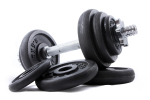|
2006/08/03, 06:08 PM
Ran across this study that may interest many looking into the fat burn realm.....
Effect of order of exercise intensity upon cardiorespiratory, metabolic, and perceptual responses during exercise of mixed intensity
Jie Kang1 , Justin S. Schweitzer1 and Jay R. Hoffman1
(1) Human Performance Laboratory, Department of Health and Exercise Science, The College of New Jersey, Ewing, NJ 08628, USA
Jie Kang
Email: kang@tcnj.edu
Phone: +1-609-7141305
Fax: +1-609-6375153
Accepted: 29 June 2003 Published online: 5 August 2003
Abstract Exercise of mixed intensities can be of benefit in many different ways. However, whether physiological interaction exists between exercises of different intensity is questionable. As such, the primary aim of this study was to examine the effect of order of exercise intensity upon cardiorespiratory, metabolic, and perceptual responses during exercise of mixed intensity. Eight males and four females volunteered to serve as subjects for the study. They were informed of the purpose of the experiment and gave their written consent to participate. Each subject completed a peak oxygen uptake (O2peak) test and two submaximal exercises of mixed intensity on three separate laboratory visits. During each submaximal exercise trial, subjects performed a 15-min (high intensity) exercise at 70%O2peak that was followed by another 15-min (low intensity) exercise at 50%O2peak (high/low, H/L), or a 15-min exercise at 50%O2peak that was followed by another 15-min exercise at 70%O2peak (low/high, L/H). Oxygen uptake (O2), respiratory exchange ratio (R), expired ventilation (E), heart rate (HR) and ratings of perceived exertion (RPE) were measured every 5 min throughout exercise. Energy expenditure and carbohydrate and fat oxidation were calculated from O2 adjusted for substrate metabolism using R and then accumulated for each phase of exercise intensity as well as for the entire exercise session. O2 and HR were higher (P<0.05), while R was lower (P<0.05) at the lower intensity in H/L than in L/H. E and RPE were lower (P<0.05) at the higher intensity in H/L than in L/H. While no differences in caloric expenditure and carbohydrate oxidation between the two trials were observed, fat oxidation was higher (P<0.05) both at the lower intensity and for the entire trial in H/L than in L/H. It appears that during exercise of mixed intensity, placing some periods of moderate intensity exercise prior to a milder one is a more favorable sequence in that it can elicit a greater fat oxidation while being felt less stressful.
--------------
Maximus from Gladiator....Strength and Honor!
|
|
|
|
2006/08/04, 12:18 AM
Rite; high intensity has always been key to get great results from the cardio side of the house.
--------------
mind and body, like man & wife, never always agree w/each other.
|
|
2006/08/04, 09:01 AM
Well, not just high intensities, seems start high,followed by low intensity burns more fat.
--------------
Maximus from Gladiator....Strength and Honor!
|
|
2006/08/04, 09:02 AM
Not surprising, I made a post about a year ago about doing cardio in that manner. First segment liberates fat from cells, second, burns them.
--------------
Maximus from Gladiator....Strength and Honor!
|
|
2006/08/04, 09:53 AM
I know I have seen much better results doing my cardio in this manner.I can go a much longer period of time on the treadmill when I vary my intensity level...almost double the amount of time in fact!hiit training has greatly improved my stamina.
|




